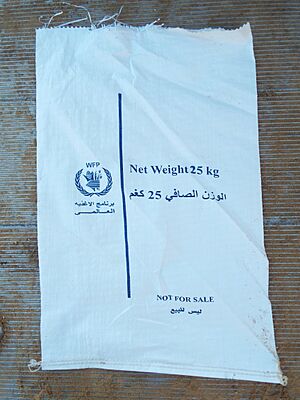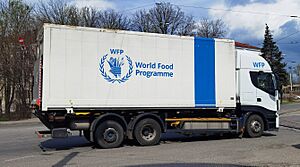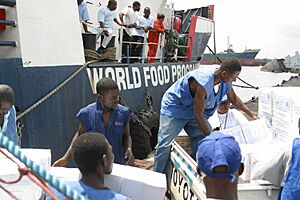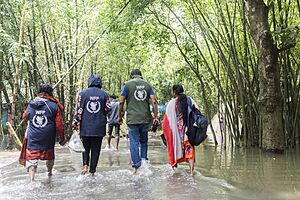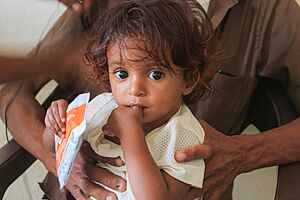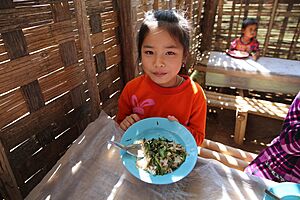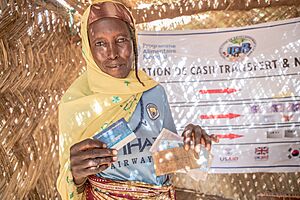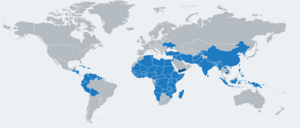World Food Programme facts for kids
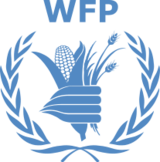 |
|
| Abbreviation | WFP |
|---|---|
| Formation | 19 December 1961 |
| Type | Intergovernmental organization, regulatory body, advisory board |
| Legal status | Active |
| Headquarters | Rome, Italy |
|
Executive Director
|
Cindy McCain |
|
Deputy Executive Director
|
Carl Skau |
|
Parent organization
|
United Nations General Assembly |
|
Staff (2023)
|
22,300+ |
| Award(s) | Nobel Peace Prize (2020) |
| Website | wfp.org |
The World Food Programme (WFP) is a special group within the United Nations (UN) that helps feed people all over the world. It's the biggest organization of its kind, giving food to people in need and providing lots of school meals. WFP started in 1961 and has its main office in Rome, Italy. It also has offices in 87 other countries. In 2023, WFP helped over 152 million people in more than 120 countries and areas.
Besides giving emergency food, WFP also helps countries prepare for emergencies. They manage how food gets from one place to another and help build strong systems to protect people from hunger. They also work to make communities stronger against climate change. WFP often gives money directly to people in need. They also run the United Nations Humanitarian Air Service (UNHAS), which flies humanitarian workers to places where they are needed.
WFP is a key part of the United Nations Sustainable Development Group. This group works to achieve 17 important goals for a better world. WFP's main goal is to reach "zero hunger" by the year 2030.
The World Food Programme won the 2020 Nobel Peace Prize in 2020. They received this award for their efforts to provide food in areas where there is conflict. They also work to stop food from being used as a weapon during wars.
Contents
History of the World Food Programme
WFP was created in 1961 after a meeting of the Food and Agriculture Organization (FAO). At that meeting, George McGovern suggested starting a program to provide food aid to many countries. WFP began its first projects in 1963. These projects helped the Nubian people in Wadi Halfa, Sudan. The program was so successful that it became a permanent organization in 1965.
Why WFP's Work is Important
WFP works on many different Sustainable Development Goals. When people don't have enough food, or suffer from malnutrition, it leads to poor health. This can affect other important areas like education, jobs, and poverty. By helping with food, WFP also helps improve these other parts of life.
How WFP Gets Funding
WFP gets most of its money from donations. Governments around the world give money, and so do companies and private donors. In 2022, WFP received a record 14.1 billion US dollars. However, they needed 21.4 billion US dollars to do all their work. The United States was the biggest donor.
In 2023, WFP received 8.3 billion US dollars. This was less than the year before, which meant they had a big funding gap.
How WFP is Organized
Leadership and Staff
WFP is guided by a board made up of representatives from 36 member countries. This board helps direct and oversee WFP's activities. The European Union also takes part in the board's work as a major donor.
WFP is led by an Executive Director. This person is chosen by the UN Secretary-General and the head of the Food and Agriculture Organization (FAO). The Executive Director serves for five years and is in charge of running the organization and its projects. Cindy McCain became the Executive Director in March 2023.
In March 2023, WFP had over 22,300 staff members working around the world.
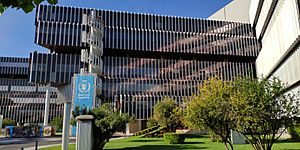
Past Executive Directors
Since 1992, all Executive Directors of WFP have been from the United States. Here is a list of those who have led the World Food Programme:
- Addeke Hendrik Boerma (
 Netherlands) (May 1962 – December 1967)
Netherlands) (May 1962 – December 1967) - Sushil K. Dev (
 India) (January 1968 – August 1968) (acting)
India) (January 1968 – August 1968) (acting) - Francisco Aquino (
 El Salvador) (July 1968 – May 1976)
El Salvador) (July 1968 – May 1976) - Thomas C. M. Robinson (
 United States) (May 1976 – June 1977 acting; July 1977 – September 1977)
United States) (May 1976 – June 1977 acting; July 1977 – September 1977) - Garson N. Vogel (
 Canada) (October 1977 – April 1981)
Canada) (October 1977 – April 1981) - Bernardo de Azevedo Brito (
 Brazil) (May 1981 – February 1982) (acting)
Brazil) (May 1981 – February 1982) (acting) - Juan Felipe Yriart (
 Uruguay) (February 1982 – April 1982) (acting)
Uruguay) (February 1982 – April 1982) (acting) - James Ingram (
 Australia) (April 1982 – April 1992)
Australia) (April 1982 – April 1992) - Catherine Bertini (
 United States) (April 1992 – April 2002)
United States) (April 1992 – April 2002) - James T. Morris (
 United States) (April 2002 – April 2007)
United States) (April 2002 – April 2007) - Josette Sheeran (
 United States) (April 2007 – April 2012)
United States) (April 2007 – April 2012) - Ertharin Cousin (
 United States) (April 2012 – April 2017)
United States) (April 2012 – April 2017) - David Beasley (
 United States) (April 2017 – April 2023)
United States) (April 2017 – April 2023) - Cindy McCain (
 United States) (Since April 2023)
United States) (Since April 2023)
What WFP Does
Helping in Emergencies
About two-thirds of WFP's food aid goes to people who are very hungry, often because of violence and conflict. More than 60% of hungry people worldwide live in areas with armed conflict. This makes it harder to get food and help to them. In 2023, over 300 million people faced severe hunger globally. WFP reported that it helped 152 million people with important aid that year.
A report from June 2024 by WFP and FAO warned that severe hunger would likely get worse in 18 "hotspots" between June and October 2024. These places face famine or are at high risk of it. Some of the most concerning countries include Haiti, Mali, Palestine, South Sudan, and Sudan.
WFP is also one of the first groups to respond when sudden disasters happen. For example, when floods hit Sudan in July 2020, WFP quickly provided emergency food to nearly 160,000 people. After Cyclone Idai hit Mozambique in early 2019, WFP gave food and vouchers. They also helped with recovery and rebuilding efforts.
WFP also tries to prevent disasters from causing too much harm. In the Sahel region of Africa, WFP works with communities to collect water for farming and restore damaged land. They also help people learn new skills to earn a living. WFP uses early warning systems to help communities get ready for disasters. In Bangladesh, weather forecasts helped WFP give money to farmers. This allowed them to prepare their homes or store food before heavy floods.
WFP leads the Logistics Cluster, which helps coordinate aid efforts. It also helps lead the Food Security Cluster. The WFP-managed United Nations Humanitarian Air Service (UNHAS) flies to over 300 places worldwide. WFP also runs the United Nations Humanitarian Response Depot (UNHRD). This is a network of centers that buy, store, and transport emergency supplies for WFP and other aid groups. WFP's help, including its air service, allowed aid workers and supplies to reach areas where regular flights were not available during the COVID-19 pandemic.
Responding to Climate Change
WFP gave money to vulnerable groups in Bangladesh before heavy rains in July 2019. Their response to Hurricane Dorian in the Bahamas in September 2019 was helped by a regional office in Barbados. This office was set up the year before to improve disaster readiness. Before Dorian, WFP sent experts to help with food security, logistics, and emergency communication.
Improving Nutrition
WFP works with governments, other UN groups, and private companies to improve food security and nutrition. This includes school meals and adding important nutrients to food.
School Meals Programs
School meals encourage parents in struggling families to send their children to school instead of work. These meals have many benefits for education, health, and local economies. WFP works with partners to make sure school meals are part of bigger health programs in schools. These programs can include things like malaria control and hygiene lessons.
Helping Small Farmers
WFP is part of the Farm to Market Alliance. This group helps small farmers get information, money, and support. This allows them to grow more food and sell it, which increases their income. WFP connects small farmers to markets in over 40 countries.
From 2008 to 2013, WFP ran a project called Purchase for Progress (P4P). This project helped 800,000 farmers in 20 countries. They learned how to grow better crops, handle food after harvest, and sell their products. This project helped farmers earn over 148 million US dollars.
Creating Community Assets
WFP's Food Assistance for Assets (FFA) program gives money or food to people in need. In return, these people help build or improve things in their communities. This could include fixing irrigation systems, bridges, or working on land and water management.
FFA helps people meet their immediate food needs while also building things that will help their communities in the long run. This program focuses on creating lasting benefits for people and places.
Giving Cash Assistance
WFP often gives money directly to people, using things like debit cards or vouchers. This gives people more choices about what they buy and helps local businesses. In the first half of 2022, WFP gave 1.6 billion US dollars in cash to 37 million people in 70 countries to help with hunger. A study in 2022 found that a WFP cash program greatly reduced poverty for people who received the money.
Building Local Skills
In areas of the Philippines that often face climate disasters, WFP provides training and equipment to local governments. They also help set up automated weather stations to prepare for emergencies.
Digital Innovations
WFP uses the latest technology and data to help achieve zero hunger. The WFP Innovation Accelerator has supported over 60 projects in 45 countries. In 2017, WFP started the Building Blocks program. This program uses blockchain technology to help Syrian refugees in Jordan get food by scanning their eyes. WFP also uses simple hydroponics kits to help refugees grow food for livestock in the Sahara desert. The SMP PLUS software is an AI tool that helps create menus for school meal programs worldwide.
Working with Partners
WFP works with governments, private companies, UN agencies, and over 1,000 non-governmental organizations. WFP, the UN Food and Agriculture Organization, and the International Fund for Agricultural Development all work together to end global hunger. In the United States, the World Food Program USA is a separate group that supports WFP's work.
Countries Where WFP Works
Afghanistan
In Afghanistan, 14.8 million people face severe food shortages.
Yemen
In Yemen, 19.5 million people need humanitarian help, and 17.1 million do not have enough food.
Recognition and Awards
WFP won the 2020 Nobel Peace Prize for its work to fight hunger and help create peace in conflict areas. They were also recognized for trying to stop food from being used as a weapon in wars. When accepting the award, Executive Director David Beasley asked wealthy people to help provide the 5 billion US dollars WFP needed to save 30 million people from famine.
See also
 In Spanish: Programa Mundial de Alimentos para niños
In Spanish: Programa Mundial de Alimentos para niños
- Asia Emergency Response Facility, a WFP project to set up an emergency response center in Asia
- Fight Hunger, a WFP effort to end child hunger
- Food Force, an educational game published by WFP
- Network for Capacity Development in Nutrition
- World Food Council, a former UN agency whose work is now done by FAO and WFP


